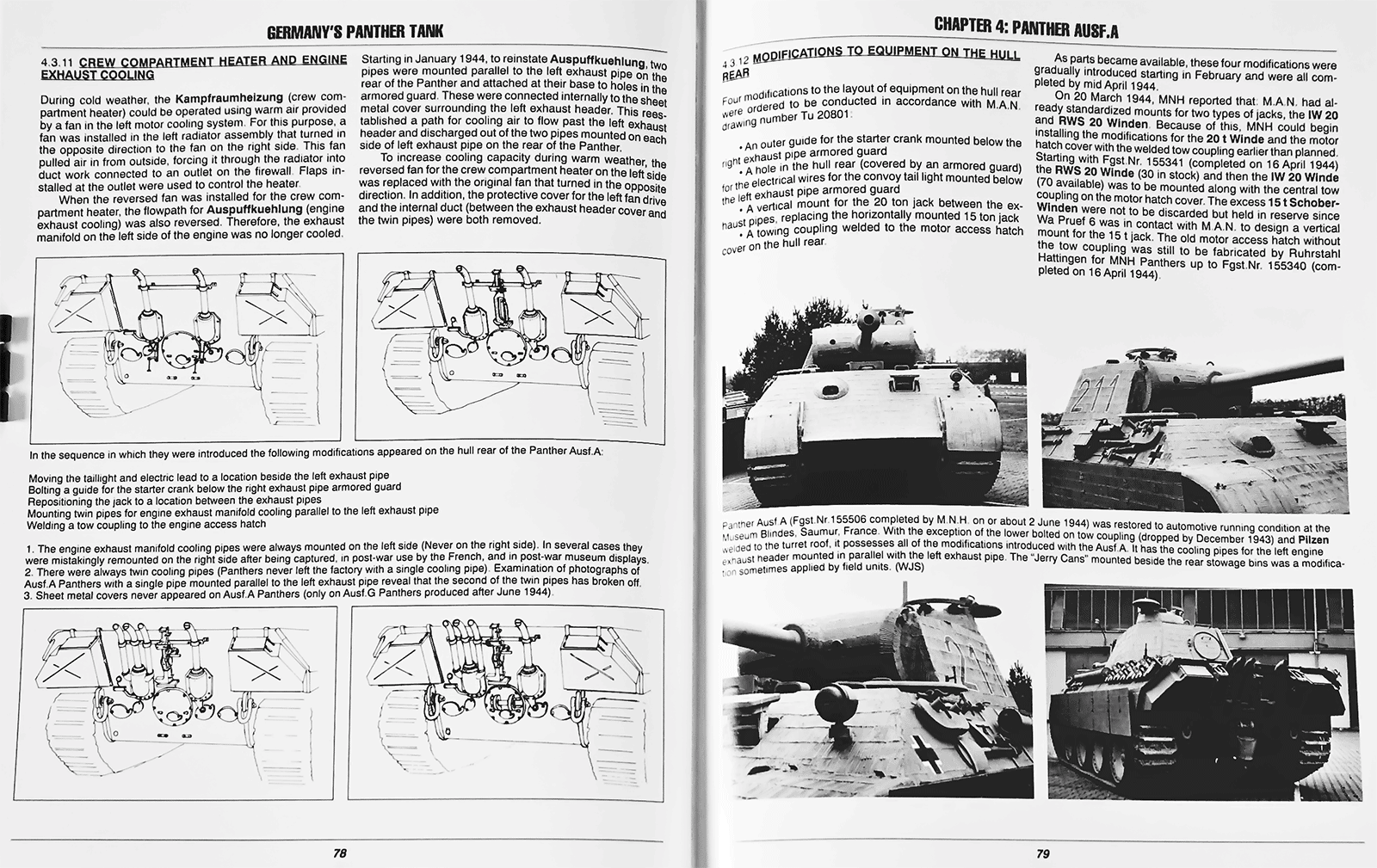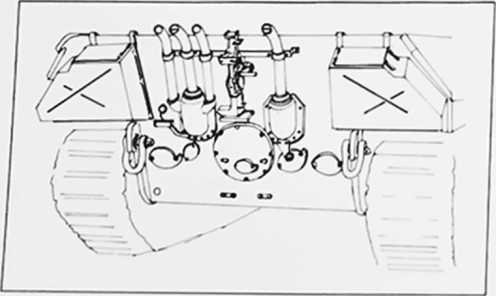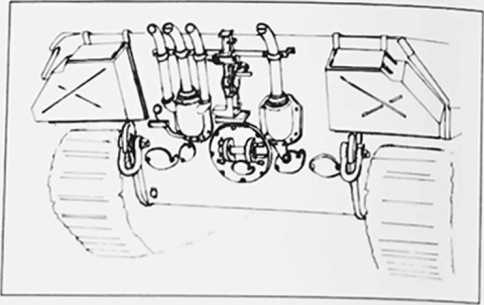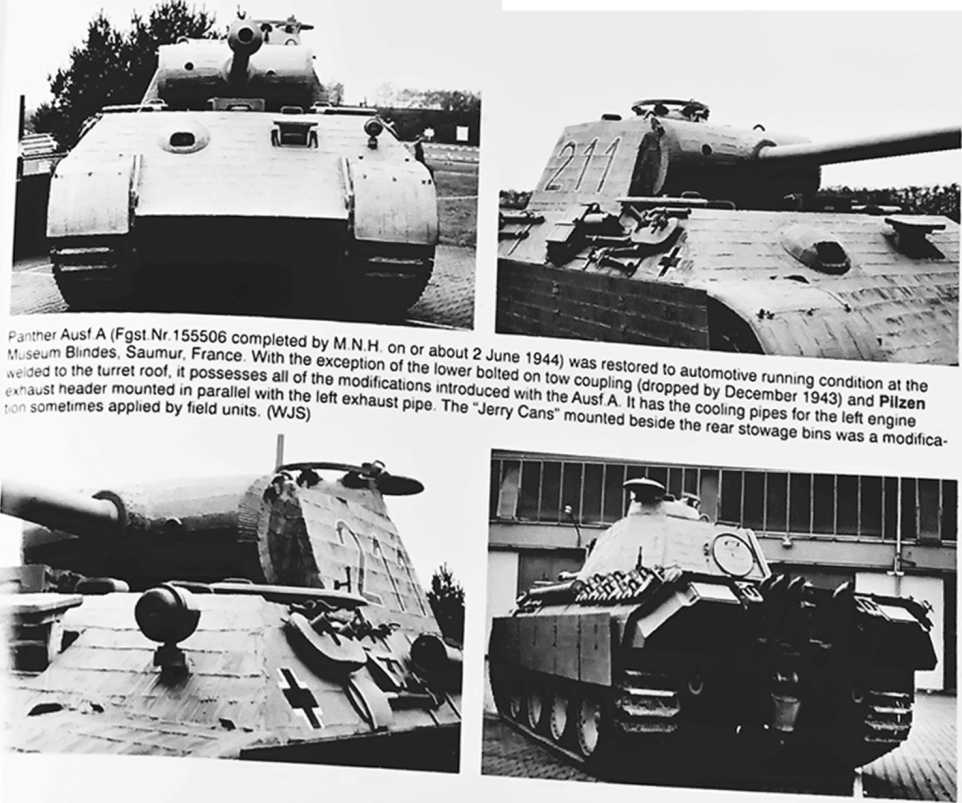041

GERMANY'S PANTHER TANK
4 3.11 CREW COMPARTMENT HEATER AND ENGINE
Durmg cold weather. the Kampfraumhelzung (crew com-partment heater) could De operated using warm air provided by a fan m the left motor coolmg system For this purpose. a fan was mstalled in the left radiator assembly that turned m the opposite direction to the fan on the nght side This fan pulled air m from outside. forcing it through the radiator mto duet work connected to an outlet on the firewall Flaps in-stalled at the outlet were used to control the heater
When the reversed fan was mstalled for the crew com-partment heater. the flowpath for Auspuffkuehlung (engine exhaust coolmg) was also reversed. Therefore. the exhaust mamfold on the left side of the engine was no longer cooled
Starting m January 1944. to remstate Auspuffkuehlung. two pipes were mounted parallel to the left exhaust pipę on the rear of the Panther and attached at their base to holes in the armored guard These were connected mternally to the sheet metal cover surroundmg the left exhaust header. This rees* tablished a path for coolmg air to flow past the left exhaust header and discharged out of the two pipes mounted on each side of left exhaust pipę on the rear of the Panther.
To merease cooling capacity during warm weather. the reversed fan for the crew compartment heater on the left side was replaced with the origmal fan that turned in the opposite direction. In addition. the protective cover for the left fan drive and the internal duet (between the exhaust header cover and the twin pipes) were both removed.

In the seguence m which they were mtroduced the followmg modifications appeared on the hull rear of the Panther Ausf.A
Movmg the taillight and electnc lead to a location beside the left exhaust pipę Boltmg a guide for the starter crank below the right exhaust pipę armored guard Repositiomng the jack to a location between the exhaust pipes Mountmg twm pipes for engine exhaust mamfold cooling parallel to the left exhaust pipę Weldmg a tow couplmg to the engine access hatch
1. The engine exhaust mamfold c™,in9p'p^ usTb^UwF^ench, and m post-war museum d.splays
were m.stakmgly remounted;*9hl .^1% nevlr left the factory w.th a smgle coolmg p.pe) Exam.nat.on of photographs of
2 There were always twm a>olmg pipes (Panthe! si nev e hauSl pipe reveai that the second of the twm pipes has broken off
Ausf.A Panthers w.th a smgle p.pe mounted fon^Ton/^jsfG Panthers produced after June 1944)
3. Sheet metal covers never appeared on Ausf A Panthers (only on aust o ran. o k


s>uNjuoiiy mtroduced star ______ «,,u w«re aii com
CHAPTBI4: PAJUTHER flUSFfl
43,2MOwncAriołiSTe£QuipJ1a^m^j^-- ^ HUShfl
were
com-
pleted by mid Apnl 1944
On 20 March 1944. MNH reported that M A N had al-_ onani m.a.N ready standardized mounts for two types of jacks. the IW 20
*raw'h9 nufTlber Tu and Wlnden Because of this. MNH could begin
• «•—-■ rs s1““1■“**
. A vemcai mouni ror me 20 ton iark ho»,. counimn"*** lu oe mountpri ain^ *»mae
naust p<pes replacing the hor.zontally moui^®?^ e ex* Wlnden we e ™°»l0rhatchCOver Thelxcess^tT?'t0w
. A towmg coupling welded to the motor Jack Wa Pruef fi L 0 be b,scarded but h 151 Schober-
CO,er on the hull rear motor ^cess hatch moun ,0 fhef. I" COn,act **£ AŃ % '£1*Se™
of me eiectncal wire auard 9 °W 70 avai,ab,e) was t0 be mounted along with the central tow
ne iett exhaust P'Pe the92o ton iack hetwppn tho o S?,U|^ing on the molor batch cover. The excess 151 Schober-. a vert.cal mount for the 20►tori jacktb® ©J- Wlnden were not to be d.scarded but held .n reserve sine* ioes. replacmg the horizontai^ mounted 15 ton jack Wa Pruef 6 was in contar** v...*k »< * *• towmg coupling welded to the motor access hatch n the hull rear

79
Wyszukiwarka
Podobne podstrony:
GERMAN Y S PANTHEH TANK was almost completed. A model of the motor was complete and was to be sent t
GERMANY S PANTHER TANK Tne omy cnass-s compieted for tne Versuchs-Panther II was captured Dy tne Ame
GERMANYS PANTHER TANK As an expedient to mcrease protection against strafing aircraft and splinters
GERMAN Y S PANTHER TANK Rhemmetall designed a Panther turret with a narrow gun mantlet. penscopic gu
GERMANYS PANTHER TANK Above and opposite above A Versuchs-Schmalturm (experimental narrow turret) mo
GERMANYS PANTHER TANK must break Also. the enemy is awakened and sent his artil-tery and mortar shel
GERMAIMY S PANTHER TANK 6) in Berlin on 28 and 29 January 1942 and recorded the results of the discu
GERMANY S PANTHER TANK The spent MG cartndge tubę pulled out when the n s depressed When the gun was
GERMANYS PANTHER TANK Dn 21 February 1943 a Jak* steer.ng gears) (CHY) :,on Au of
GERMANY S PANTHER TANK I Befehls-Panther Ausf D. Tactical Nr 155. possessed the last changes madę to
GERMANY S PANTHER TANK Drawmg No H-Sk A 86176 dated 7 November 1943 shows a machmegun mount for a Pa
GERMANYS PANTHER TANK Panther Ausf A (Fgst Nr 152151 produced by Daimler-Benz on 0r about 16 Decembe
GERMANV S PANTHER TANK 7.5 cm Kw.K.42 L 70 Extornal Travel Lock Commandor’8 Cudoi* 021St
GERMANYS PANTHER TANK Panzarkampfwagen Panther (7.5 cm Kw.K.42 L.70) (Sd.Ktz.171) An Auafuehrung A w
GERMANYS PANTHER TANK 4 3 13 WATERTLGHT SEALS BEHINB THE GUN MANTLET On 16 March 1944 MNH was mforme
GERMANYS PANTHER TANK Track dOjustment left 48306 48306 Track ad
GERMANY S PANTHER TANK any Panther completed m November The Panthers already prepared for msiallatio
GERMANYS PANTHER TANK succeed in producmg a single 1 32 m rangefmder before the end ot ihe war Devel
GERMANY S PANTHER TANK Table 9.1.2:
więcej podobnych podstron